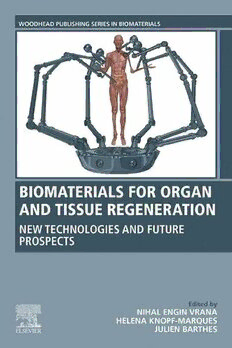
Biomaterials for Organ and Tissue Regeneration: New Technologies and Future Prospects PDF
Preview Biomaterials for Organ and Tissue Regeneration: New Technologies and Future Prospects
Biomaterials for Organ and Tissue Regeneration Woodhead Publishing Series in Biomaterials Biomaterials for Organ and Tissue Regeneration New Technologies and Future Prospects Edited by Nihal Engin Vrana Helena Knopf-Marques Julien Barthes WoodheadPublishingisanimprintofElsevier TheOfficers’MessBusinessCentre,RoystonRoad,Duxford,CB224QH,UnitedKingdom 50HampshireStreet,5thFloor,Cambridge,MA02139,UnitedStates TheBoulevard,LangfordLane,Kidlington,OX51GB,UnitedKingdom Copyright©2020ElsevierLtd.Allrightsreserved. Nopartofthispublicationmaybereproducedortransmittedinanyformorbyanymeans, electronicormechanical,includingphotocopying,recording,oranyinformationstorageand retrievalsystem,withoutpermissioninwritingfromthepublisher.Detailsonhowtoseek permission,furtherinformationaboutthePublisher’spermissionspoliciesandourarrangements withorganizationssuchastheCopyrightClearanceCenterandtheCopyrightLicensingAgency, canbefoundatourwebsite:www.elsevier.com/permissions. Thisbookandtheindividualcontributionscontainedinitareprotectedundercopyrightbythe Publisher(otherthanasmaybenotedherein). Notices Knowledgeandbestpracticeinthisfieldareconstantlychanging.Asnewresearchandexperience broadenourunderstanding,changesinresearchmethods,professionalpractices,ormedical treatmentmaybecomenecessary. Practitionersandresearchersmustalwaysrelyontheirownexperienceandknowledgein evaluatingandusinganyinformation,methods,compounds,orexperimentsdescribedherein.In usingsuchinformationormethodstheyshouldbemindfuloftheirownsafetyandthesafetyof others,includingpartiesforwhomtheyhaveaprofessionalresponsibility. Tothefullestextentofthelaw,neitherthePublishernortheauthors,contributors,oreditors, assumeanyliabilityforanyinjuryand/ordamagetopersonsorpropertyasamatterofproducts liability,negligenceorotherwise,orfromanyuseoroperationofanymethods,products, instructions,orideascontainedinthematerialherein. BritishLibraryCataloguing-in-PublicationData AcataloguerecordforthisbookisavailablefromtheBritishLibrary LibraryofCongressCataloging-in-PublicationData AcatalogrecordforthisbookisavailablefromtheLibraryofCongress ISBN:978-0-08-102906-0(print) ISBN:978-0-08-102907-7(online) ForinformationonallWoodheadPublishingpublications visitourwebsiteathttps://www.elsevier.com/books-and-journals Publisher:MatthewDeans AcquisitionsEditor:SabrinaWebber EditorialProjectManager:PeterAdamson ProductionProjectManager:JoyChristelNeumarin HonestThangiah CoverDesigner:ChristianJ.Bilbow CoverImageCredit:IlkerGazioglu TypesetbyMPSLimited,Chennai,India Contents Listofcontributors xix Preface xxvii Acknowledgment xxix Section 1 Properties and forms of biomaterials 1 1 Introductiontobiomaterialsfortissue/organregeneration 3 NihalEnginVrana 1.1 Introduction 3 1.2 Manyfacetsofnewbiomaterials:newnaturallysourcedbiomaterials, newsyntheticbiomaterials,materiomics,metabiomaterials 4 1.3 Off-shoottechnologieslinkedtobiomaterialsandtissue engineering:biorobotics,bioinks,andbioprinting 8 1.4 Biomaterialriskassessment 10 1.5 Conclusion 15 Acknowledgment 15 References 15 2 Physicochemicalpropertiesofbiomaterials 19 VincentBall 2.1 Introduction 19 2.2 Bulkpropertiesofbiomaterials 20 2.2.1 Shapeandsizecontrol 20 2.2.2 Mechanicalproperties 20 2.2.3 Corrosionanddegradationinagivenchemicalenvironment 22 2.2.4 Controlofporosity,poresize,andporeconnectivity 22 2.3 Surfacepropertiesofbiomaterials 23 2.3.1 Surfaceenergy-hydrophilicity 23 2.3.2 Lackoftoxicity,ofunfavorableimmunologicalresponse, hemocompatibility 25 2.3.3 Surfacetopography 25 2.3.4 Proteinadsorption 25 2.3.5 Versatilemodificationofthebiomaterials’surfacechemistry 26 2.3.6 Degradabilityofsurfacecoatings 27 2.3.7 Antibacterialproperties 27 2.3.8 Activebiomaterials 28 vi Contents 2.4 Propertiesofbiomimeticbiomaterials 28 2.5 Real-timemonitoringofanimplantedbiomaterial andpersonalizedimplants 29 2.6 Conclusionandperspectives 29 References 30 3 Polymer-basedcompositesformusculoskeletalregenerativemedicine 33 PatrinaS.P.Poh,MariaA.WoodruffandElenaGarcı´a-Gareta Abbreviations 33 3.1 Introduction 34 3.2 Abriefhistoryofcomposites 35 3.3 Polymer-basedcompositesscaffoldcharacteristics 36 3.3.1 Mechanicalproperties 36 3.3.2 Biodegradationproperties 39 3.4 Polymer-basedcompositescaffoldsforspecificmusculoskeletal tissueregeneration 43 3.4.1 Bone 43 3.4.2 Cartilageandosteochondralregeneration 51 3.4.3 Tendon,ligament,andenthesisregeneration 54 3.4.4 Skeletalmuscleregeneration 55 3.5 Thenecessityfornerveandvascularregeneration 57 3.5.1 Importanceofvasculatureandinnervationforskeletal muscleregeneration 57 3.5.2 Importanceofvasculatureandinnervationforbone regeneration 57 3.6 Nerveregeneration 58 3.6.1 Compositebiomaterialapproachfornerveregeneration 58 3.7 Vascularregeneration 65 3.7.1 Fabricationofpolymer-basedcompositescaffoldsthat incorporateavascularnetwork 65 3.7.2 Engineeringofsmalldiameterbloodvessels(,6mm) withpolymer-basedcomposites 66 3.8 Conclusionandfutureprospects 67 Acknowledgments 68 References 68 4 Emergingbiotechnologicalapproacheswithrespecttotissue regeneration:fromimprovingbiomaterialincorporationto comprehensiveomicsmonitoring 83 RabahGahoual,Yannis-NicolasFranc¸ois, NathalieMignetandPascalHouze´ 4.1 Introduction 83 4.2 Analyticalmethodologiesforproteinidentificationandmonitoring 84 4.3 Massspectrometry(cid:1)basedproteomicanalysis 87 4.3.1 Samplepreparationforproteomicsexperiments 88 Contents vii 4.3.2 Peptidemixtureanalysisbyliquidchromatography coupledtotandemmassspectrometry 90 4.3.3 Proteinidentification 92 4.3.4 Applicationsofproteomicanalysistothedevelopment ofbiomaterialsfortissueregeneration 94 4.4 Analyticalmethodologiesadaptedtoproteinstructural characterization 98 4.4.1 Samplepreparation 100 4.4.2 Tandemmassspectrometry(cid:1)basedanalysis ofposttranslationalmodifications 101 4.5 Conclusion 104 References 105 5 Useofnanoscale-deliverysystemsintissue/organregeneration 113 MiladFathi-Achachelouei,DilekKeskinandAysenTezcaner 5.1 Introduction 113 5.2 Propertiesandapplicationareasofnanoscale-deliverysystemsin biomedicalfield 114 5.2.1 Deliverysystemsfortherapeuticpurpose 114 5.2.2 Deliverysystemsfortissueandorganregeneration 114 5.3 Nanoscale-deliverysystemsforregenerationpurposes 115 5.3.1 Morphologicalclassificationofnanoscale-deliverysystems 116 5.4 Emergingdeliverytechnologiesinnanoparticlearea 139 5.4.1 Microfluidicdevicesforproductionofnanoparticles 139 5.4.2 Recruiting3Dprintingandnanoparticlesfortissue engineeringapplications 140 5.5 Conclusionandfutureperspectives 141 References 142 6 Surfacefunctionalizationofbiomaterialsforcellbiologyapplications 163 E.AdaCavalcanti-AdamandWenqianFeng 6.1 Introduction 163 6.1.1 Fromartificialtobioinspiredmaterials:challenges atthecell(cid:1)materialinterface 163 6.2 Engineeringthecell(cid:1)materialinterface 164 6.2.1 Surfacemimicsoftheextracellularmatrix 165 6.2.2 Chemicalandspatialcontrolofcelladhesion tosurfacematerials 166 6.3 Deliverystrategiesforgrowthfactorsatthecell(cid:1)materialinterface 169 6.3.1 Biofunctionalizationstrategiesfortailoringthe spatiotemporaldeliveryofgrowthfactors 170 6.3.2 Guidanceofcellresponsesbygrowthfactorscomplexedwith surfacematerials 171 6.4 Conclusionandoutlook 172 References 173 viii Contents 7 Stemcells:sources,properties,andcelltypes 177 MelisAsalandSinanGu¨ven 7.1 Introduction 177 7.2 Stemcellproperties 177 7.2.1 Self-renewal 177 7.2.2 Potency 179 7.3 Celltypes 180 7.3.1 Embryonicstemcells 180 7.3.2 Inducedpluripotentstemcells 182 7.3.3 Adultstemcells 183 7.4 Applicationsofstemcellsintissueengineering 188 7.5 Conclusion 192 References 193 8 Immunecells:sources,properties,andcelltypes 197 S.JungandFlorentMeyer Abbreviations 197 8.1 Introduction 198 8.2 Immunesystemconsiderationintheuseofbiomaterials andtissueregeneration 199 8.2.1 Overalldescriptionoftheimmunesystem:innateversus adaptivesystem(“knowyourbasics”) 199 8.2.2 Tissueregeneration/woundhealing (“whyimmunesystemissoimportant”) 202 8.2.3 Immuneresponsetobiomaterials:whenallgoes wrong,thatis,theforeignbodyreaction 205 8.3 Immunecelldescription 209 8.3.1 Myeloidcells 209 8.3.2 Innate-likelymphocytes 213 8.3.3 Lymphocytes 216 8.4 Immunecellsourcing 220 8.5 Invivotesting 222 8.6 Conclusion 223 References 223 9 Cellsignalingandstrategiestomodulatecellbehavior 231 ClaireEhlinger,DominiqueVautierandLeylaKocgozlu 9.1 Introduction 231 9.1.1 Howtomodulatecelladhesion,cellmigration,andcell extrusion? 232 9.1.2 Syntheticmatricestocontrolcellprogrammingand reprogramming 235 9.1.3 Nuclearmechanicsandmechanicalmemory 239 9.2 Conclusion 241 Acknowledgments 242 References 242 Contents ix Section 2 Biomaterials use in organ specific applications 247 10 Cardiovasculartissueengineering 249 RichardA.O’Connor,PaulA.CahillandGarrettB.McGuinness 10.1 Introduction 249 10.2 Thecardiovascularsystem 250 10.2.1 Arterialtissue 250 10.2.2 Cardiactissue 251 10.3 Cardiovasculardisease 252 10.4 Coronaryarterybypassgrafting 253 10.4.1 Vasculargrafts 254 10.4.2 Roleofbiomechanicalcompliance 255 10.5 Tissue-engineeredbloodvessels 257 10.5.1 Biomaterialsfortissue-engineeredbloodvessels 261 10.5.2 Stemcellsintissue-engineeredbloodvesselapplications 262 10.6 Electrospinningoftissue-engineeredbloodvessels 263 10.6.1 Fundamentalsofelectrospinning 264 10.6.2 Electrospinningparameters 264 10.6.3 Collectorsystemsforcreatingelectrospunvessels 264 10.6.4 Limitationsofelectrospunscaffolds 266 10.7 Futureoutlookforcardiovasculartissueengineering 266 Acknowledgments 267 References 267 11 Bioartificialgut—currentstateofsmallintestinaltissueengineering 273 ThomasDa¨ullary,ChristinaFey,ConstantinBerger, MarcoMetzgerandDanielaZdzieblo 11.1 Introduction 273 11.2 Thesmallintestine—structuralorganizationandfunction 273 11.3 Modelingthesmallintestine—biologymeetsengineering 278 11.3.1 Modelingthesmallintestineinvitrobytwo-dimensional monolayercellcultures 278 11.3.2 Smallintestinalorganoids—artificialminiorgans growninvitro 280 11.4 SmallintestinaltissueengineeringintheTranswell—whencells meetscaffolds 283 11.5 Next-generationmodels—integrationofmicroenvironmental factors 284 11.6 Outlook 288 References 289 12 Frominsulinreplacementtobioengineered,encapsulatedorganoids 299 ElisaMaillardandSe´verineSigrist 12.1 Introduction 299 12.2 Pancreas 299 x Contents 12.3 Pancreaticislet 299 12.3.1 Compositionofpancreaticislets 301 12.3.2 β-Cellsroleandinsulinfunction 302 12.4 Diabetes 303 12.4.1 Type1diabetes 304 12.4.2 Type2diabetes 304 12.4.3 Gestationaldiabetes 305 12.4.4 Otherdiabetes 305 12.4.5 Poorglycemiaregulationcomplications 305 12.5 Insulinreplacementfortype1diabetes 306 12.5.1 Glucosemeasurements 306 12.5.2 Exogenousinsulin 307 12.5.3 Endogenousinsulinproduction 309 12.6 Islettransplantationlimits(Fig.12.5) 311 12.6.1 Lowisolationyieldandhighpancreasrequirement 311 12.6.2 Extracellularmatrixdestruction 312 12.6.3 Hypoxia 312 12.6.4 Instantblood-mediatedinflammatoryreaction 312 12.6.5 Autoimmunityandalloimmunity 313 12.6.6 Immunesuppressiveregimen 313 12.7 Improvementsinislettransplantation(Fig.12.7) 313 12.8 Othersourcesofinsulin-secretingcells 316 12.8.1 Cellsofanimalorigin 316 12.8.2 Surrogatecells 318 12.9 Thebioartificialpancreas 320 12.9.1 Definition 320 12.9.2 Microencapsulation 321 12.9.3 Macroencapsulation 322 12.10 Conclusion 325 References 325 13 Diabeticwoundhealingwithengineeredbiomaterials 335 LauraE.Castellano,JorgeDelgado,ArturoVega-Gonza´lezand BirzabithMendoza-Novelo 13.1 Introduction 335 13.2 Impairedwoundhealingunderconditionofdiabetes 335 13.2.1 Diabeticfootulcercomplications 335 13.2.2 Cellularandmoleculareventsindiabeticfootulcer 336 13.2.3 Implicationofadvancedglycationendproducts oncellfunction 337 13.2.4 Epigeneticchangesrelatedtodiabeticfootulcer 339 13.3 Physicochemicalaspectsandfabricationofbiomaterials indiabeticwoundhealing 340 13.3.1 Hydration 340 13.3.2 Oxygenation 340 13.3.3 Infectioncontrol 341
